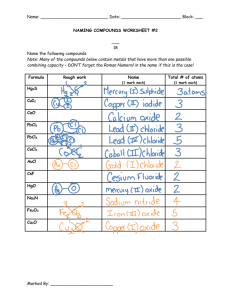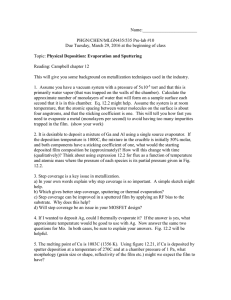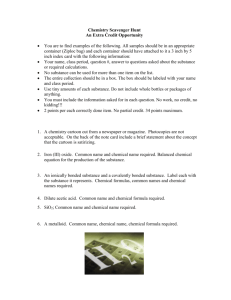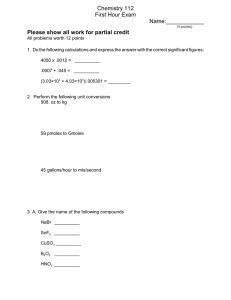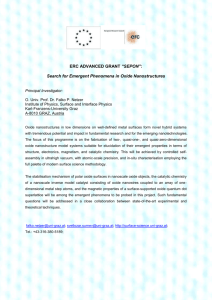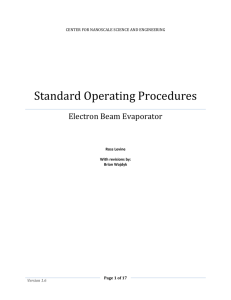Standard Operating Procedures Electron Beam Evaporator CENTER FOR NANOSCALE SCIENCE AND ENGINEERING
advertisement
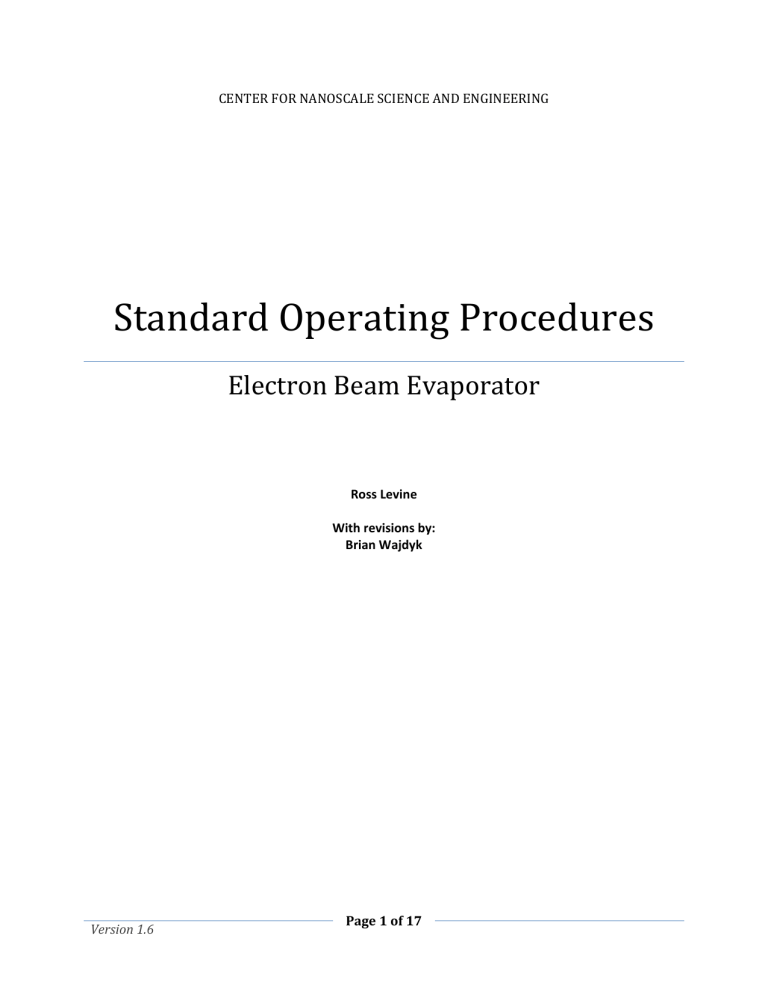
CENTER FOR NANOSCALE SCIENCE AND ENGINEERING Standard Operating Procedures Electron Beam Evaporator Ross Levine With revisions by: Brian Wajdyk Version 1.6 Page 1 of 17 Important Gloves should be worn while handling substrate and deposition to reduce contamination. Always rotate the “Output Voltage” and “Emission” dials slowly to avoid an arc fault or possibly burning out the filament. Always clamp the chamber door shut; failure to do so can result in machine breakdown. You can only use CeNSE laboratories and equipment if you have been approved by Brian or Chuck, reserved the tool on the calendar, and filled out a form. No Exceptions! If the equipment is acting unusual STOP! Please discuss with Brian or Chuck before proceeding and leave a note on the machine. Any accidental damage must be reported immediately. All CeNSE laboratories are protected by video surveillance. Version 1.6 Page 2 of 17 Machine Exterior (excluding chamber) Version 1.6 Page 3 of 17 Chamber Exterior and Interior Version 1.6 Page 4 of 17 Operating Procedure 1. Preparation 1.1. Before beginning, be sure to wear gloves to reduce contamination and to protect the hands. 1.2. Place each deposition material into a crucible. Crucibles should be marked for their specific deposition material. 2. Load the sample 2.1. Open the chamber door: 2.1.1. Unlock the chamber by releasing the four clamps that hold it in place. 2.1.2. Press the “stop process” button on the processing controls (figure 1a). 2.1.3. Press the “reset” button on the processing controls (figure 1a). 2.1.4. Wait 1‐2 minutes for the pressure to stabilize before proceeding. 2.1.5. Press the “vent” button on the processing controls (figure 1a). 2.1.6. Wait for the chamber to vent. The door should open slightly when this is complete. 2.1.7. Press the “reset” button on the processing controls (figure 1a). 2.2. Clamp the substrate to the stage: 2.2.1. Open the chamber door fully. 2.2.2. Remove the mounting screw on the underside of the stage (figure 2a). 2.2.3. Slide the stage out from the holder (figure 2a). 2.2.4. Clamp the substrate to the underside of the stage using the spring clamps. 2.2.5. Replace the stage and mounting screw. 2.3. Insert deposition materials: 2.3.1. Remove the shutter by pulling toward left side of chamber. (figure 2b). 2.3.2. Insert the crucible with the deposition material (not more than 2/3 full) into the deposition material pocket (figure 2a). To use multiple materials, turn the deposition materials rotator one full rotation to open a new pocket. 2.4. Check the condition of the thickness monitor sensor. Press the “Crystal” button found on the thickness monitor (figure 1c). 2.4.1.If the display shows less than 75% let a CeNSE staff member replace it for you. It is still usable at this point. If no one is available to replace it you can send a CeNSE staff member an email 2.5. Close the chamber: 2.5.1. Replace the shutter. Just slide it back into the fitting. (figure 2b) 2.5.2. Close the chamber door. 2.5.3. Tighten the four door clamps. 2.6. Pump down the chamber 2.6.1.Press the “start” button on the processing controls (figure 1a) to start the low vacuum pump. Torr; it is then safe to continue. 2.7. Wait until the vacuum pressure is below Version 1.6 Page 5 of 17 Operating Procedure, continued 2.8. Press the “process” button on the processing controls (figure 1a) to start the high vacuum pump. 3. Configure the deposition thickness monitor 3.1. Press the “program” button on the deposition panel (figure 1c). 3.2. Using the dial on the film controls (figure 1c), select the film number that corresponds to the deposition material in the table in Appendix A. 3.3. Press the “next” button (figure 1c). This will load the material parameters into memory. Ensure that the material parameters match those listed in Appendix A. 3.4. Press the “program” button again to save the selection (figure 1c). 4. Configure for deposition 4.1. Wait until the vacuum pressure is below Torr; for best results wait longer for pressure lower than 9x10‐6Torr. 4.2. Press and hold the “filament check” switch under the source 1 controls (figure 1a) until a glow can be seen through the chamber window. Once the glow is visible, release the switch. 4.3. Turn on the power: 4.3.1. Switch on the horizontal and lateral control power (figure 1a). 4.3.2. Enable (flip upwards) mains power on the power controls (figure 1b). 4.3.3. Press the “HV on” button on the power controls (figure 1b). 4.4. Set the desired output voltage, in kV, by rotating the HV output control knob slowly (fig 1b). Rotating the knob too quickly will result in an arc fault. 4.4.1. If you have an arc fault you will need to turn the power back to 0kV. 4.4.2. Press the “HV off” button. 4.4.3.Go back to 4.3.3. 4.5. Press the “on” button for the source 1 controls (figure 1a). 4.6. Slowly rotate the “emission” dial (figure 1a) until you can see a pressure change. 4.7. Continue to increase the current until the beam spot can be seen. Sometimes it can be hard to find. Try wiggling the vertical or horizontal position control. 4.8. Aim the electron beam: 4.8.1. Look through the viewing mirror at the glowing spot formed by the electron beam. 4.8.2. Adjust the location of the beam by using the horizontal and lateral “position” dials (figure 1a). 4.8.3. Move the beam in to the center of the crucible. 4.8.4. For materials that sublimate or are poor thermal conductors (e.g. carbon). 4.8.4.1. Adjust the area of coverage by using the “amplitude” dials (figure 1a). 4.8.4.2. Adjust the frequency of the beam’s movement by using the “frequency” dials (figure 1a). 4.9. Now heat up the deposition material until it glows dull orange. Version 1.6 Page 6 of 17 4.9.1.Optional: Leave it at this point for a minute or two and see if the vacuum recovers. If it does continue to wait until it stabilizes. This helps degas the deposition material. 5. Deposit material: 5.1.1. Continue to adjust to the desired deposition rate. 5.1.1.1. Technique is everything. It is hard to get a consistent deposition rate. The tendency is to overshoot or undershoot the desired rate. Unless the deposition rate is going up very fast, make very small changes and wait a minute for the change to occur. Remember that even though the change in current is instant, the change in the temperature isn’t. One way to tell how far off you are from your ideal rate is how fast it is changing. When you are close, the rate change slows. Additionally, as your deposition material is being used up the current per unit area increases causing a slow increase in deposition rate. Nope. You can’t walk away. 5.1.2. Open the shutter release the set screw, pull the shutter control open, and tighten the set screw (figure 2b) 5.1.3. Quickly press the “zero” button (figure 1c) to re‐zero the deposition thickness measurement. 5.1.4. Wait until the desired deposition thickness is achieved. Operating Procedure, continued 6. End Deposition 6.1. Close the shutter by releasing the set screw, replacing the shutter control, and tightening the set screw again (figure 1c). 6.1.1.Note: The vacuum wants to pull it back in. Be careful to slide it in slowly. Failure to do this will cause the shutter to fall in the chamber. This inevitably causes contamination and possibly expensive repairs. 6.2. Slowly rotate the source 1 “emission” dial (figure 1a) until the indicator reaches zero. 6.3. Press the “off” button on the source 1 controls (figure 1a). 6.4. If performing multiple depositions, configure the new deposition as described in steps 3.1‐3.3, turn the deposition materials rotator 360°, and begin the next deposition from step 5.4. 7. End processing 7.1. Turn off the power: 7.1.1. Switch off the horizontal and lateral control power (figure 1a). 7.1.2. Slowly turn HV output control knob (figure 1b) until the output voltage reaches zero. 7.1.3. Press the “HV off” button on the power controls (figure 1b). 7.1.4. Disable mains power on the power controls (figure 1b). 7.2. Wait at least 20 minutes for the chamber to cool before proceeding. Version 1.6 Page 7 of 17 7.3. Open the chamber door: 7.3.1. Unlock the chamber by releasing the four clamps that hold it in place. 7.3.2. Press the “stop process” button on the processing controls (figure 1a). 7.3.3. Press the “reset” button on the processing controls (figure 1a). 7.3.4. Press the “vent” button on the processing controls (figure 1a). 7.3.5. Wait for the chamber to vent. The door should open slightly when this is complete and you may here the hissing of the N2 purge gas. 7.3.6. Press the “reset” button on the processing controls (figure 1a) to stop the purge gas. 7.4. Open the door; remove the substrate (see step 2.2) and crucible(s). 8. When you are done with the machine 8.1. 8.2. 8.3. 8.4. Close the chamber door and tighten the clamps on the (now empty) chamber. Press the “start” button on the processing controls (figure 1a). Torr; it is then safe to continue. Wait until the vacuum pressure is below Press the “process” button on the processing controls (figure 1a). Version 1.6 Page 8 of 17 Appendix A: Film selection This table is used in step 3.2 to determine which film to select. Film Number Deposition Material Density Z‐Ratio Film 1 Film 2 Film 3 Film 4 Film 5 Film 6 Film 7 Film 8 Film 9 Aluminum Titanium Copper Gold Silicon Nickel Platinum Silicon Dioxide Custom 2.70 4.50 8.93 19.3 2.32 8.91 21.4 2.648 1.08 0.628 0.437 0.381 0.712 0.331 0.245 1.00 See below Using film 9 to set your own deposition material: 1. Refer to the next pages for material properties for your deposition material. 2. Use only film 9 for custom settings. Never change the settings for films 1‐8. 3. When setting the film number as per step 3.2 in the operating procedure, turn the dial on the film controls until “Film 9” is displayed. 4. Press the “next” button. 5. Rotate the dial to set the density to the appropriate value. 6. Use the “next” and “previous” buttons to cycle through density, tooling factor, z‐ratio, and desired final thickness. If you make a mistake, press the “clear” button. 7. Press the “program” button when done to save your settings. Proceed to step 4 of the operating procedures. Version 1.6 Page 9 of 17 Deposition material properties: Formula Ag AgBr AgCl Al Al2O3 Al4C3 AlF3 AlN AlSb As As2Se3 Au B B2O3 B4C BN Ba BaF2 BaN2O6 BaO BaTiO3 BaTiO3 Be BeF2 BeO Bi Bi2O3 Bi2S3 Bi2Se3 Bi2Te3 BiF3 C C C8H8 Ca CaF2 CaO CaO‐SiO2 Version 1.6 Density 10.5 6.47 5.56 2.70 3.97 2.36 3.07 3.26 4.36 5.73 4.75 19.3 2.37 1.82 2.37 1.86 3.5 4.886 3.244 5.72 5.999 6.035 1.85 1.99 3.01 9.8 8.9 7.39 6.82 7.7 5.32 2.25 3.52 1.1 1.55 3.18 3.35 2.9 Z‐Ratio 0.529 1.18 1.32 1.08 0.336 ? ? ? 0.743 0.966 ? 0.381 0.389 ? ? ? 2.1 0.793 1.261 ? 0.464 0.412 0.543 ? ? 0.79 ? ? ? ? ? 3.26 0.22 ? 2.62 0.775 ? ? Acoustic Impedance 16.69 7.48 6.69 8.18 26.28 11.88 9.14 23.18 22.70 4.20 11.13 7.00 19.03 21.43 16.26 11.18 2.71 40.14 3.37 11.39 Page 10 of 17 Material Name Silver Silver Bromide Silver Chloride Aluminum Aluminum Oxide Aluminum Carbide Aluminum Fluoride Aluminum Nitride Aluminum Antimonide Arsenic Arsenic Selenide Gold Boron Boron Oxide Boron Carbide Boron Nitride Barium Barium Fluoride Barium Nitrate Barium Oxide Barium Titanate (Tetr) Barium Titanate (Cubic) Beryllium Beryllium Fluoride Beryllium Oxide Bismuth Bismuth Oxide Bismuth Trisuiphide Bismuth Selenide Bismuth Telluride Bismuth Fluoride Carbon (Graphite) Carbon (Diamond) Parlyene (Union Carbide) Calcium Calcium Fluoride Calcium Oxide Calcium Silicate (3) Formula CaSO4 CaTiO3 CaWO4 Cd CdF2 CdO CdS CdSe CdTe Ce CeF3 CeO2 Co CoO Cr Cr2O3 Cr3C2 CrB Cs Cs2SO4 CsBr CsCl CsI Cu Cu2O Cu2S Cu2S CuS Dy Dy2O3 Er Er2O3 Eu EuF2 Fe Fe2O3 FeO FeS Ga Ga2O3 Version 1.6 Density 2.962 4.1 6.06 8.64 6.64 8.15 4.83 5.81 6.2 6.78 6.16 7.13 8.9 6.44 7.2 5.21 6.68 6.17 1.87 4.243 4.456 3.988 4.516 8.93 6 Cu2S Cu2S CuS Dy Dy2O3 Er Er2O3 Eu EuF2 7.86 5.24 5.7 4.84 5.93 5.88 Z‐Ratio 0.955 ? ? 0.682 ? ? 1.02 ? 0.98 ? ? ? 0.343 0.412 0.305 ? ? ? ? 1.212 1.41 1.399 1.542 0.437 ? 5.6 5.8 4.6 8.55 7.81 9.05 8.64 5.26 6.5 0.349 ? ? ? 0.593 ? Acoustic Impedance 9.25 12.95 8.66 9.01 25.74 21.43 28.95 7.29 6.26 6.31 5.73 20.21 1.58 1.52 1.92 1.03 1.13 0.98 1.02 1.68 1.36 25.30 14.89 Page 11 of 17 Material Name Calcium Sulfate Calcium Titanate Calcium Tungstate Cadmium Cadmium Fluoride Cadmium Oxide Cadmium Sulfide Cadmium Selenide, Cadmium Telluride Cerium Cerium (III) Fluoride Cerium (IV) Dioxide Cobalt Cobalt Oxide Chromium Chromium (III) Oxide Chromium Carbide Chromium Boride Cesium Cesium Sulfate Cesium Bromide Cesium Chloride Cesium Iodide Copper Copper Oxide Copper (I) Sulfide (Alpha) Copper (I) Sulfide (Beta) Copper (II) Sulfide Dysprosium Dysprosium Oxide Erbium Erbium Oxide Europium Europium Fluoride Iron Iron Oxide Iron Oxide Iron Sulphide Gallium Gallium Oxide (B) Formula GaAs GaN GaP GaSb Gd Gd2O3 Ge Ge3N2 GeO2 GeTe Hf HfB2 HfC HfN HfO2 HfSi2 Hg Ho Ho2O3 In In2O3 In2Se3 In2Te3 InAs InP InSb Ir K KBr KCl KF KI La La2O3 LaB6 LaF3 Li LiBr LiF LiNbO3 Version 1.6 Density 5.31 6.1 4.1 5.6 7.89 7.41 5.35 5.2 6.24 6.2 13.09 10.5 12.2 13.8 9.68 7.2 13.46 8.8 8.41 7.3 7.18 5.7 5.8 5.7 4.8 5.76 22.4 0.86 2.75 1.98 2.48 3.128 6.17 6.51 2.61 5.94 0.53 3.47 2.638 4.7 Z‐Ratio 1.59 ? ? ? 0.67 ? 0.516 ? ? ? 0.36 ? ? ? ? ? 0.74 0.58 ? 0.841 ? ? ? ? ? 0.769 0.129 10.189 1.893 2.05 ? 2.077 0.92 ? ? ? 5.9 1.23 0.778 0.463 Acoustic Impedance 5.55 13.18 17.11 24.53 11.93 15.22 10.50 11.48 68.45 0.87 4.66 4.31 4.25 9.60 1.50 7.18 11.35 19.07 Page 12 of 17 Material Name Gallium Arsenide Gallium Nitride Gallium Phosphide Gallium Antimonide Gadolinium Gadolinium Oxide Germanium Germanium Nitride Germanium Oxide Germanium Telluride Hafnium Hafnium Boride, Hafnium Carbide Hafnium Nitride Hafnium Oxide Hafnium Silicide Mercury Holminum Holminum Oxide Indium Indium Sesquioxide Indium Selenide Indium Telluride Indium Arsenide Indium Phosphide Indium Antimonide Iridium Potassium Potassium Bromide Potassium Chloride Potassium Fluoride Potassium Iodide Lanthanum Lanthanum Oxide Lanthanum Boride Lanthanum Fluoride Lithium Lithium Bromide Lithium Fluoride Lithium Niobate Formula Lu Mg MgAl2O4 MgAl2O6 MgF2 MgO Mn MnO MnS Mo Mo2C MoB2 MoO3 MoS2 Na Na3AlF6 Na5AL3F14 NaBr NaCl NaClO3 NaF NaNO3 Nb Nb2O3 Nb2O5 NbB2 NbC NbN Nd Nd2O3 NdF3 Ni NiCr NiCrFe NiFe NiFeMo NiO P3N5 Pb PbCl2 Version 1.6 Density 9.84 1.74 3.6 8 3.18 3.58 7.2 5.39 3.99 10.2 9.18 7.12 4.7 4.8 0.97 2.9 2.9 3.2 2.17 2.164 2.558 2.27 8.578 7.5 4.47 6.97 7.82 8.4 7 7.24 6.506 8.91 8.5 8.5 8.7 8.9 7.45 2.51 11.3 5.85 Z‐Ratio ? 1.61 ? ? 0.637 0.411 0.377 0.467 0.94 0.257 ? ? ? ? 4.8 ? ? ? 1.57 1.565 0.949 1.194 0.492 ? ? ? ? ? ? ? ? 0.331 ? ? ? ? ? ? 1.13 ? Acoustic Impedance 5.48 13.86 21.48 23.42 18.91 9.39 34.36 1.84 5.62 5.64 9.30 7.40 17.95 26.68 7.81 Page 13 of 17 Material Name Lutetium Magnesium Magnesium Aluminate Spinel Magnesium Fluoride Magnesium Oxide Manganese Manganese Oxide Manganese (II) Sulfide Molybdenum Molybdenum Carbide Molybdenum Boride Molybdenum Trioxdide Molybdenum Disulfide Sodium Cryolite Chiolite Sodium Bromide Sodium Chloride Sodium Chlorate Sodium Fluoride Sodium Nitrate Niobium (Columbium) Niobium Trioxide Niobium (V) Oxide Niobium Boride Niobium Carbide Niobium Nitride Neodynium Neodynium Oxide Neodynium Fluoride Nickel Nichrome Inconel Permalloy Supermalloy Nickel Oxide Phosphorus Nitride Lead Lead Chloride Formula PbF2 PbO PbS PbSe PbSnO3 PbTe Pd PdO Po Pr Pr2O3 Pt PtO2 Ra Rb Rbl Re Rh Ru S8 Sb Sb2O3 Sb2S3 Sc Sc2O3 Se Si Si3N4 SiC SiO SiO2 Sm Sm2O3 Sn SnO2 SnS SnSe SnTe Sr SrF2 Version 1.6 Density 8.24 9.53 7.5 8.1 8.1 8.16 12.038 8.31 9.4 6.78 6.88 21.4 10.2 5 1.53 3.55 21.04 12.41 12.362 2.07 6.62 5.2 4.64 3 3.86 4.81 2.32 3.44 3.22 2.13 2.648 7.54 7.43 7.3 6.95 5.08 6.18 6.44 2.6 4.277 Z‐Ratio 0.661 ? 0.566 ? ? 0.651 0.357 ? ? ? ? 0.245 ? ? 2.54 ? 0.15 0.21 0.182 2.29 0.768 ? ? 0.91 ? 0.864 0.712 *1000 ? 0.87 1 0.89 ? 0.724 ? ? ? ? ? 0.727 Acoustic Impedance 13.36 15.60 13.56 24.73 36.04 3.48 58.87 42.05 48.52 3.86 11.50 9.70 10.22 12.40 10.15 8.83 9.92 12.20 12.15 Page 14 of 17 Material Name Lead Fluoride Lead Oxide Lead Sulfide Lead Selenide Lead Stannate Lead Telluride Palladium Palladium Oxide Polonium Praseodymium Praseodymium Oxide Platinum Platinum Oxide Radium Rubidium Rubidium Iodide Rhenium Rhodium Ruthenium Sulphur Antimony Antimony Trioxide Antimony Trisulfide Scandium Scandium Oxide Selenium Silicon Silicon Nitride Silicon Carbide Silicon (II) Oxide Silicon Dioxide Samarium Samarium Oxide Tin Tin Oxide Tin Sulfide Tin Selenide Tin Telluride Strontium Strontium Fluroide Formula SrO Ta Ta2O5 TaB2 TaC TaN Tb Tc Te TeO2 Th ThF4 ThO2 ThOF2 Ti Ti2O3 TiB2 TiC TiN TiO TiO2 Tl TlBr TlCl TlI U U3O8 U4O9 UO2 V V2O5 VB2 VC VN VO2 W WB2 WC WO3 WS2 Version 1.6 Density 4.99 16.6 8.2 11.15 13.9 16.3 8.27 11.5 6.25 5.99 11.694 6.32 9.86 9.1 4.5 4.6 4.5 4.93 5.43 4.9 4.26 11.85 7.56 7 7.09 19.05 8.3 10.969 10.97 5.96 3.36 5.1 5.77 6.13 4.34 19.3 10.77 15.6 7.16 7.5 Z‐Ratio 0.517 0.262 0.3 ? ? ? 0.66 ? 0.9 0.862 0.484 ? 0.284 ? 0.628 ? ? ? ? ? 0.4 1.55 ? ? ? 0.238 ? 0.348 0.286 0.53 ? ? ? ? ? 0.163 ? 0.151 ? ? Acoustic Impedance 17.08 33.70 29.43 13.38 9.81 10.24 18.24 31.09 14.06 22.08 5.70 37.10 25.37 30.87 16.66 54.17 58.48 Page 15 of 17 Material Name Strontium Oxide Tantalum Tantalum (V) Oxide Tantalum Boride Tantalum Carbide Tantalum Nitride Terbium Technetium Tellurium Tellurium Oxide Thorium Thorium (IV) Fluoride Thorium Dioxide Thorium Oxyfluoride Titanium Titanium Sesquioxide Titanium Boride Titanium Carbide Titanium Nitride Titanium Oxide Titanium (IV) Oxide Thallium Thallium Bromide Thallium Chloride Thallium Iodide (B) Uranium Tri Uranium Octoxide Uranium Oxide Uranium Dioxide Vanadium Vanadium Pentoxide Vanadium Boride Vanadium Carbide Vanadium Nitride Vanadium Dioxide Tungsten Tungsten Boride Tungsten Carbide Tungsten Trioxide Tungsten Disulphide Formula WSi2 Y Y2O3 Yb Yb2O3 Zn Zn3Sb2 ZnF2 ZnO ZnS ZnSe ZnTe Zr ZrB2 ZrC ZrN ZrO2 Version 1.6 Density 9.4 4.34 5.01 6.98 9.17 7.04 6.3 4.95 5.61 4.09 5.26 6.34 6.49 6.08 6.73 7.09 5.6 Z‐Ratio ? 0.835 ? 1.13 ? 0.514 ? ? 0.556 0.775 0.722 0.77 0.6 ? 0.264 ? ? Acoustic Impedance 10.57 7.81 17.18 15.88 11.39 12.23 11.47 14.72 33.45 Page 16 of 17 Material Name Tungsten Suicide Yttrium Yttrium Oxide Ytterbium Ytterbium Oxide Zinc Zinc Antimonide Zinc Fluoride Zinc Oxide Zinc Sulfide Zinc Selenide Zinc Telluride Zirconium Zirconium Boride Zirconium Carbide Zirconium Nitride Zirconium Oxide Appendix B: Tooling Factor (optional) How do I determine Tooling Factor? Tooling Factor adjusts for the difference in material deposited on the quartz sensor versus the substrate. This is an inherent problem. We don’t want to cover your sample with the detector! Tooling may be less than or greater than 100% as shown below. 1. Place your substrate and a new quartz sensor in their normal position. 2. Set Tooling to an approximate value; Set Density and Z-Factor for your material. 3. Deposit approximately 1000 to 2500 Å of material. 4. Use a profilometer to measure the substrate’s film thickness. 5. The correct Tooling Factor is calculated by: Why do I determine Tooling Factor? It is necessary for very accurate deposition. Version 1.6 Page 17 of 17
